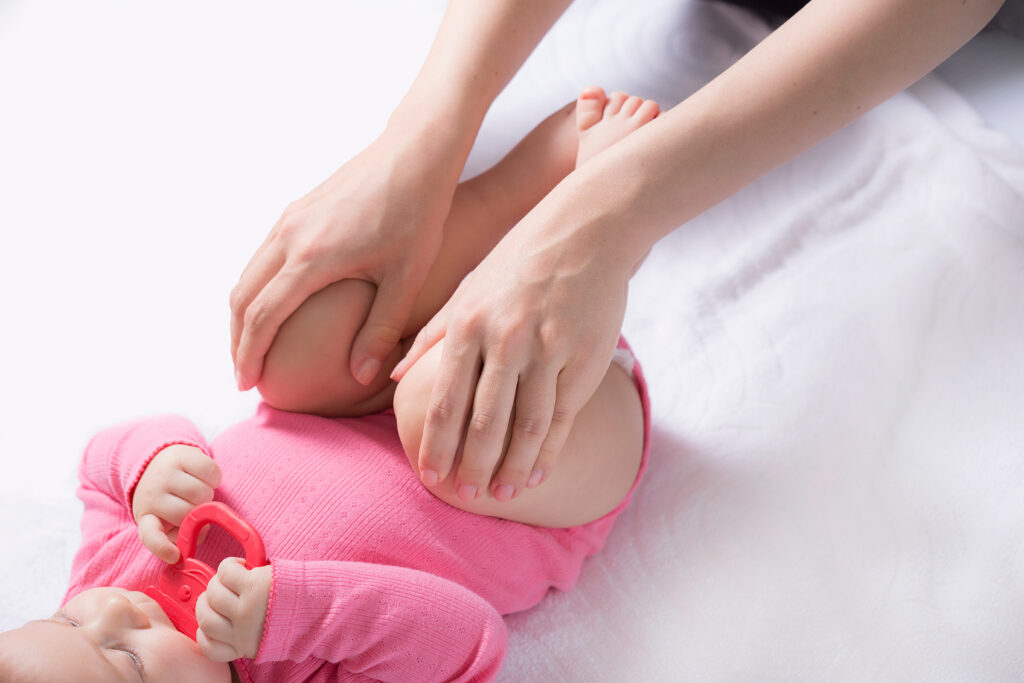Hip dysplasia in infants is a condition that can quietly affect a baby’s hip development, sometimes going unnoticed until it causes discomfort or mobility issues later in life. Early awareness and intervention are essential to support healthy growth and prevent long-term complications.
What Is Developmental Dysplasia of the Hip (DDH)?
Developmental dysplasia of the hip (DDH) occurs when the hip socket doesn’t fully cover the ball of the femur, the upper thigh bone. This can lead to partial or complete dislocation of the hip joint. DDH may be present at birth or develop over time. Symptoms are often subtle, making early detection critical. In some cases, physical signs such as asymmetrical leg folds, uneven leg length, or limited range of motion may appear, but imaging is often required to confirm a diagnosis.
How Breech Presentation Increases DDH Risk
Babies born in a breech position—feet or buttocks first—face a higher risk of developing DDH. Studies show that 15–20% of breech infants experience hip dysplasia, particularly first-born girls, due to tighter uterine conditions. Additional risk factors include a family history of DDH, multiple pregnancies, or low amniotic fluid. Awareness of these risks allows pediatricians to monitor infants closely and refer to pediatric orthopedic specialists when necessary.
Screening Methods: Physical Exams, Ultrasound, Imaging
Early detection is key for hip dysplasia in infants. Pediatricians commonly use a combination of physical exams and imaging techniques:
- Barlow Maneuver: Tests if the hip can be gently dislocated.
- Ortolani Test: Checks if a dislocated hip can be repositioned into the socket.
- Ultrasound Screening: Ideal for babies under six months to visualize the hip joint.
- X-Rays: Used for older infants and toddlers to assess femur and acetabulum alignment.
Prompt and accurate diagnosis allows for timely treatment and reduces the likelihood of invasive interventions.
Treatment Options—Harnesses, Casting, Surgery & Follow-Up
Treatment depends on the severity of the dysplasia and the infant’s age:
- Pavlik Harness: The first-line treatment for most infants, holding the hip in a safe position to allow natural molding of the femur into the socket. Worn full-time for 8–18 weeks, with over 90% achieving resolution.
- Casting: Used when harness treatment is insufficient or in older infants.
- Surgical Options:
- Closed Reduction: Hip is gently repositioned into the socket.
- Open Reduction: Surgery to remove obstacles preventing proper alignment.
- Periacetabular Osteotomy (PAO): For older children or teenagers to reposition the hip socket and prevent future arthritis.
Follow-up is critical to monitor hip development and ensure long-term joint health.
Risk Reduction: Swaddling Tips and Early Monitoring
Proper swaddling can reduce DDH risk. Avoid tightly wrapping a baby’s legs straight together; instead, allow the hips to bend and move naturally. Parents should also:
- Monitor leg symmetry and hip movement.
- Attend all pediatric well-baby visits.
- Seek early referral to a pediatric orthopedic specialist if risk factors are present.
These steps, combined with education on breech birth risks, can prevent long-term complications.
Emerging Technologies: AI in DDH Diagnosis
Artificial intelligence (AI) is becoming a valuable tool in pediatric orthopedics. AI can assist in:
- Detecting subtle hip abnormalities on ultrasound images.
- Supporting early diagnosis before physical symptoms appear.
- Predicting which infants may require more intensive treatment.
AI complements traditional screening methods, helping specialists make faster, more accurate clinical decisions.
Specialized Care at The Pediatric Orthopedic Center
At The Pediatric Orthopedic Center, we focus on personalized care for infants with hip dysplasia. Our team combines expert clinical evaluation with advanced imaging techniques to ensure early detection and effective treatment. Whether using a Pavlik harness, casting, or surgical intervention, our goal is to support healthy hip development and lifelong mobility.
Early referral and consistent monitoring are essential for success. With proper intervention, most infants with hip dysplasia can achieve normal hip function and enjoy an active, healthy childhood.
Takeaway: Hip dysplasia in infants is common, especially among breech births and high-risk populations. Early detection through physical exams, ultrasound, and AI-supported diagnostics, combined with proper treatment and safe swaddling practices, can ensure optimal hip development and prevent long-term complications.



